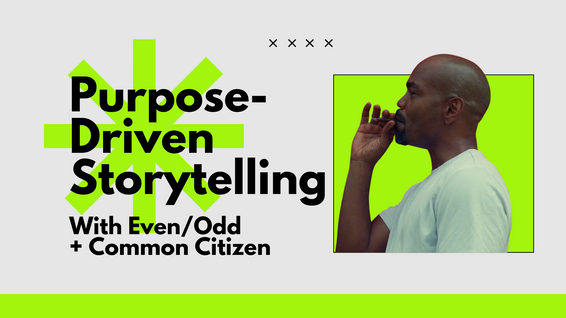Purpose-Driven Storytelling with Even/Odd + Common Citizen
Jordan P. Kelley, Content Director, Brand Storytelling

Bringing awareness to brand initiatives is one of the most powerful ways that brands can implement storytelling to achieve purpose-driven impact. “Somewhere Higher”, a short showcasing fresh, alternative, and diverse narratives within the Detroit cannabis subculture and community does just that, and for a good cause. The marijuana anthology and “visual mixtape” shares 15 mini-vignettes about the lifestyle, culture, and art born from cannabis culture in Detroit. The film from Even/Odd was made with support from Michigan-based cannabis company Common Citizen, whose initiative to help reinvigorate areas negatively impacted by the criminalization of Cannabis led to the making of the film.
Brand Storytelling caught up with Even/Odd Head of Content Omid Fatemi and Director of External Affairs and Social Equity at Common Citizen Jess Jackson to learn more about the importance of telling real people’s stories in order to connect emotionally and ethically with audiences:
What was the original seed of this film? How did it turn from an idea into a production? Omid Fatemi: Common Citizen had this initial product they were launching called Principle, essentially a pre-rolled joint. The point was to create a product skew in their offering where 100% of the proceeds went to help rebuild and fund artistic communities in Detroit, as the war on drugs disproportionately affected POC communities in Detroit. Common Citizen’s agency Higher Power reached out to Even/Odd and from there, Even/Odd Director/Founder Mohammad Gorjestani and our team brainstormed how to make a film around Principle, but also a larger piece of art that responded to that situation. With this project, Common Citizen has the opportunity to destigmatize the use of cannabis and introduce its authentic history. We eventually had the idea of the anthology film “Somewhere Higher,” where we would feature different individuals–a diverse cross-section of age, location, gender, race, etc.–and cover all the points we wanted to articulate: that cannabis use doesn’t have a particular cross-section of people. We started to research interesting stories and people around Michigan that would fit the anthology. We worked with people on the ground, local journalists, and our personal contacts, and found amazing locals that were willing to share their stories with us. Through the process of sharing those stories, Mohammad was able to develop even more ideas about the cinematic qualities of the film.
The film is, at its center, one that intends to inform and educate its audience. What was done to achieve those goals in bringing this film to life? OF: The original goal of Mohammad in particular was to make a good film. He found the best way to make a captivating film was to include as many of these disparate stories as possible and let the viewer piece them together themselves. So much material in films and expression around this stuff is centered on setting an agency, or trying to proselytize, etc., and that wasn’t the approach for this. It was actually Mohammad honestly presenting the union of stories across Michigan, knowing they would lead people to a logical conclusion. Ultimately, it’s really just about people and their stories, and respecting and honoring the fact that we had real humans who shared very intimate stories with us. Our ability to weave those into a film is something we consider an honor and take seriously.
What was the appeal on the part of Common Citizen to get involved in a project like this? Jess Jackson: Common Citizen believes in Cannabis for Humanity and Liberation for All. This documentary centers on the stories of community members and leaders who have been putting in the work to normalize and destigmatize cannabis from their lived experiences. We commissioned this documentary to amplify the stories within it and to help support the launch of our Community Reinvestment program Principle, which reinvests 100% of profits from the sales of our Principle pre-rolls into micro-grants for the community. The stories and talent within the film represent these types of communities and projects we are aiming to support.
How did you find the film’s subjects? What informed the choice to photograph them in their natural settings? OF: We had an intensive research and casting process in E/O. We’re known for story-finding; we have a process where we comb journalists, locals, and our own connections, and began to vet and build a pool of people. Then we interviewed those people. There’s no real shortcut to it, but lots of work, grinding and connecting, and following their story threads as much as possible.
Who is this film for and where is it intended to be showcased?OF: We wanted to create a film that could be shown on its own merits. Anyone interested in film could resonate with it–not just people interested in cannabis or Michigan. This was a microcosm of something the whole world was wrestling with. Our understanding of drugs and how they impact our lives, what is/is not a drug, etc., evolves as a society. This film is part of that reconciliation process. We have a history with the War on Drugs that doesn’t necessarily match the role drugs play in everyday society. What we’re trying to do as a society is reconcile that.
What do you think is the value of putting people’s personal experiences on screen? OF: The value of hyper-specific personal experiences is that they’re actually easier for people to connect with. They feel real. If you talk about broad general things, you lack human specificity. When you have real people watching those stories, even if they’re unique stories, humans can relate and digest those stories more easily. JJ: Documenting community stories humanizes people and their experiences. “Somewhere Higher” specifically shares the lived experiences of many that are often unheard and underrepresented. It helps these marginalized communities be seen and supported, and their issues amplified.
View the original article HERE.
